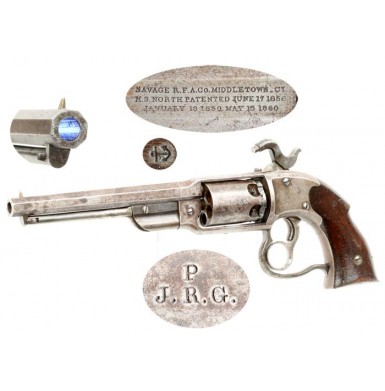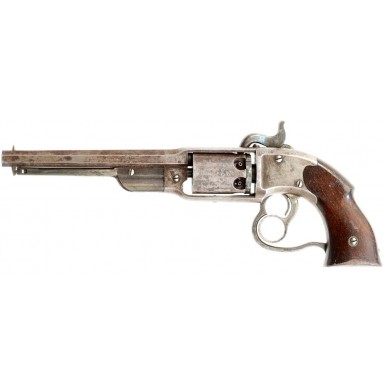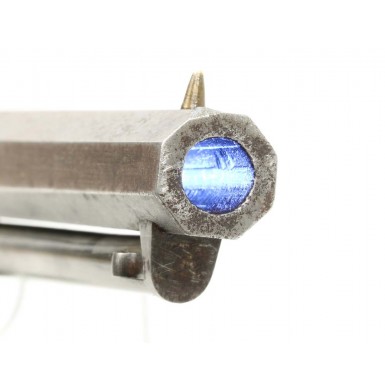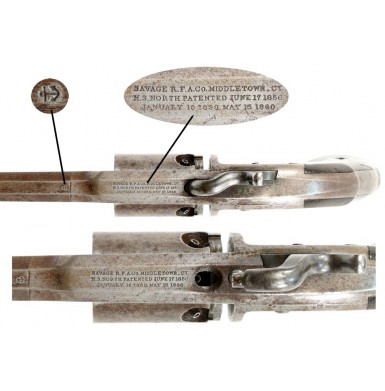The Savage “Navy” self-cocking revolver is one of the weirdest, and possibly most ungainly handguns of the Civil War era, but also has one of the most recognizable profiles. The .36 caliber, 6-shot revolver had a 7” octagonal barrel and an innovative ring-cocking action and a moving gas seal cylinder. The gun featured a unique ring shaped cocking lever inside the heart shaped trigger guard, which was used to advance the cylinder and cock the hammer. The shooter could then fire the gun with the traditional trigger. The design was similar to the lock work employed in William Tranter’s “double trigger” revolvers. The gun was the final version of a family of self-cocking revolvers that were built upon the “Figure-8” design of JS North. Beyond its unique action, the gun was revolutionary in that was a “gas seal” revolver. The cylinder moved forward when the action cocked, and a recess in the chamber mouth engaged the tapered forcing cone at the rear of the barrel. The effect was a gas seal between the chamber and the barrel, which practically eliminated the loss of gas and pressure from the usual gap between the barrel and cylinder. This meant that the gas created from the ignition of the powder charge was more effectively converted into propulsion for the bullet. This increased the velocity of the bullet for a given powder charge over convectional revolver designs, which allowed much of the propulsive force to escape in the space between the cylinder and the barrel. This innovative design would not be revisited again on a widespread basis for a military revolver until the adoption of the M-1895 Nagant revolver by the Russian military. From the very beginning, the revolver had been intended as a martial arm by its inventors and manufacturers, and significant effort was put forth in the years preceding the Civil War to obtain a US military contract for the innovative, if somewhat cumbersome revolvers. With the coming of the Civil War, the need for revolvers outweighed any misgivings that the military may have had about the design, and the coveted contracts were almost immediately forthcoming. The state of Massachusetts procured 285 of the Savage revolvers early in the conflict. Additional arms were sold to military outfitters and New York based arms retailers like Schuyler, Hartley & Graham and William Syms & Brothers. Both of these companies sold Savage Navy revolvers to the US government during early 1862, for as much as $25 per gun. The Savage Revolving Firearms Company secured its first official US military contract directly with the US government on October 16, 1861. This contract called for Savage to deliver 5,000 pistols between October 1861 and March 1862 at the price of $20 per revolver. Another contract was received from the government in November of 1861 to supply an additional 5,000 revolvers, at $20 each, between November 1861 and May of 1862. Savage completed their initial contract in a timely fashion, but had trouble delivering the guns for the second contract on the agreed to schedule. The second contract was temporarily voided by the Ordnance Department, but after negotiating with Savage, an agreement was reached where the 4,500 outstanding guns from that contract would be delivered at the lower rate of $19.00 per pistol. The deliveries under the second contract were completed by July of 1862. Of the approximately 20,000 Savage “Navy” models produced during the Civil War, the US Ordnance Department took delivery of 11,384 of the guns, and the Navy took delivery of 1,126 (although only 800 were part of an official contract). The balance of approximately 8,500 guns were offered for civilian sale, although most of those revolvers no doubt ended up seeing action during the war as well. The pistols saw significant field service during the war, and were issued to at least twenty-six different US cavalry regiments and were listed among the arms of some half dozen or more Confederate cavalry regiments. US volunteer cavalry regiments that were issued Savage Navy revolvers included the 6th, 10th & 13th Illinois, the 5th & 15th Kansas, 11th Kentucky, the 3rd, 4th & 7th Missouri, 7th New York 3rd Ohio, 7th Pennsylvania, 1st & 2nd Wisconsin, 1st Vermont and the Potomac Brigade. The revolvers were also issued to the 1st through 9th Missouri State Militia Cavalry. The two regiments who carried the most Savages on their ordnance rolls were the 4th Missouri State Militia Cavalry with 714 and the 2nd Wisconsin with 400. Confederate cavalry units that listed the Savage Navy among their arms were the 11th Texas, 7th Virginia, and the 34th & 35th Virginia Cavalry Battalions.
As mentioned above, the US Navy also procured a small number of the Savage revolvers, a total of 1,126. Of these 800 were received via contract, with an order for 800 of the handguns being placed on May 7, 1861. The contract price was $20 each, and the revolvers were delivered over the next four months, with the final 100 pistols being delivered in September. These contract guns went through the standard US Navy inspection process and were marked on the cylinder by the inspecting officer. The two primary inspectors were Commanders Guert Gansevoort and John R. Goldsborough, who marked the guns they inspected either “G.G” or “J.R.G”, respectively. The inspection process had been officially revised in 1864 and required the inspector to place a “P” over his initials on the face of the cylinder of revolvers, and a small anchor on the top of the barrel at the frame junction. These instructions were interpreted somewhat loosely and often the “P” is found under the initials of the inspector instead of above them. Additionally, the initials are often found on the side of the cylinder, rather than the face. This may have something to do with the ease of cylinder removal from the revolver (the cylinder of a Savage Navy can be particularly difficult remove, while the cylinder of a Whitney Navy is rather easy to take out of the frame). The remaining 326 were acquired on the open market. These guns did not receive US Naval inspection marks at the time of acquisition, but may have received them later as part of the post-war reinspection process. The Savage Navy revolvers saw service on a number of US Naval vessels, including the USS St. Lawrence, which received 100 of the pistols in late May or early June of 1861, certainly from the very first contract deliveries. The Savage revolvers were also parts of the small arms compliments of the USS James Alger, the USS Stars & Stripes, the USS Young Rover, the USS DeSoto, the USS Beauregard, the USS J.C. Kuhn, and USS South Carolina. All of these ships served in the various blockading squadrons that attempted to interdict trade with the Confederacy. The first three ships all served on station with the Atlantic Blockading Squadron, with the balance seeing service with the Gulf Blockading Squadron. The USS Young Rover was later reassigned from the Atlantic Blockading Squadron to the Potomac Flotilla.
After the war, the Ordnance Department disposed of the Savage Navy revolvers rather quickly. They sold some 773 during 1866 at prices varying from $1.50 to $3.45 each. During 1875, they sold an additional 3,951 of the revolvers for prices as low as $0.35 to as high as $0.58 each; a far cry from the $19 to $25 each they paid during the war years. US Naval records indicate that only 317 Savage Navy revolvers were still in inventory as of December 1, 1866, suggesting that the Navy also disposed the guns rather quickly.
This example of the Savage Revolving Firearms Company “Navy-Navy” Revolver is in about VERY GOOD+ condition overall. It is a very crisp, US Naval marked example that is 100% complete and correct in every way and retains some traces of its original finish. Savage Navy revolvers have a reputation for being difficult to find with any amount of original finish, or with grips that are not in relatively rough shape. This gun retains some traces of original blue in protected areas, and retains a much better than average set of grips. These .36 caliber, six-shot revolvers also had a reputation for being very temperamental mechanically during the period of use, and finding one that is in perfect mechanical working order today is quite difficult. This pistol is mechanically excellent and functions exactly as it should in every way. As is typical of Savage Navy revolvers, the gun is serial numbered on the frame, under the grips. The later production Savage Navy revolvers are typically found with an assembly number as well, while earlier production guns did not include an assembly number and used the serial number on the major components. In this case, the serial number on the rearward portion of the right grip frame, under the right grip is 1838. The matching serial number 1838 is present on the bottom of the barrel (this requires the removal of the cylinder arbor pin and loading mechanism to see), and is also lightly penciled on the interior of the left grip panel, although it is essentially illegible. The rear of the cylinder and the ratchet plate are both unnumbered, but are clearly original to the revolver and match its overall appearance and patina perfectly. The top strap of the revolver is clearly marked in three lines: SAVAGE R.F.A. Co. MIDDLETOWN, CT / H.S. NORTH PATENTED JUNE 17 1856 / JANUARY 10 1859. MAY 15 1860. The markings are often light on these revolvers, so it is nice to see one where they are deep, crisp and very clear. As has already been mentioned, the action of the revolver works perfectly, with a long, heavy pull of the ring beneath the trigger indexing the cylinder to the rear, rotating it and then locking it into the forward position and cocking the hammer. A single pull of this lever prepares the six shot, .36-caliber (hence the name “Navy”) revolver, to fire. Pulling the trigger releases the hammer as it should. The revolver retains some traces of blue, with the balance of the gun having a somewhat mottled patina with plum tones and brown over a dull pewter base color. The case-hardened hammer retains about 20% of its original dulling, mottled case colors, and the triggerguard and ring lever retain some strong traces of the case coloring as well, maybe as much as 10%. The balance of the triggerguard has dulled and has mixed with a smoky gray patina, with some oxidized brown discoloration. The loading lever retains similar traces of finsh as well. There are some scattered areas of surface oxidation present on the metal as well as some scattered light pitting and pinpricking. There is also some light pitting and minor erosion around the recessed cone seats of the cylinder and on the inside of the top strap and around the hole through which the centrally slung hammer engages the percussion caps. Savage Navy revolvers are notorious for having heavily battered and damaged cones, probably because of the way the hammer strikes them and because there is potential for the hammer to drag on the cone if the operating lever is not pulled briskly. As such, broken and shattered cones are a common condition issue with these revolvers. This gun is the exception and all the cones (nipples) are all in relatively crisp and usable condition. The gun retains the original tall brass cone shaped front sight, which is still full height and remains quite crisp. This is nice as the sight is typically worn down to a bead or missing completely. The brass cone is thicker on the early production revolvers than on the guns produced later in the contract series, and this gun shows the thick sight as it should. All the edges of the metal are still very sharp and crisp. The bore is in about VERY GOOD overall condition as well. It is mostly partly bright, with crisp rifling, showing some minor debris and accumulated gunk along its length along with some light pitting with a couple of patches of more moderate oxidation present as well. The original loading lever is in place under the barrel and remains fully functional, operating smoothly as it should. The lever and its retaining catch both function perfectly and the lever locks securely into place when not in use. The gun is marked with the Civil War era US Navy inspection marks of a capital P, over the initials J.R.G., the mark of Commander John R. Goldsborough. The gun is also marked with the later “anchor” reinspection mark on the top of the barrel where it meets the frame. The two-piece grips rate about VERY GOOD overall and are much better than average examples of Savage Navy grips. They show some light to moderate wear along with handling marks, scratches and dings, but are free of any breaks, cracks or repairs. The thin panels are often severely cracked, damaged, repaired or even replaced. The lower leading edge of the left grip does show a minor chip, but it is quite small and barely worth mentioning. The grips do appear to have had a light coat of old varnish added to them long ago, which is probably the reason they have survived in such nice, solid condition.
Overall this a really wonderful example of an extremely scarce and desirable, US Navy marked Savage Navy revolver, in nice, solid condition; certainly in better condition than the large majority of surviving examples. Finding a US Navy marked Savage Navy is very difficult, as the navy only took delivery of about 5% of the total production, and only about 10% of the military production. For a serious Civil War naval collector, this is a must have revolver, and is one that rarely appears on the market for sale. The gun certainly shows wear and use, but remains 100% complete and correct in every way, and for a gun that likely spent most of the war on duty with a blockading squadron, it was likely subjected to some very harsh condition. I can’t remember the last time I had a US Navy marked Savage Navy available for sale, so don’t miss your opportunity to add a very scarce variant of the Savage Navy to your collection.
SOLD







